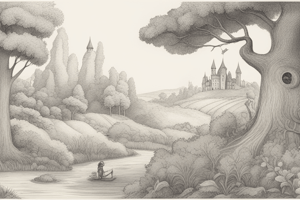Podcast
Questions and Answers
What is the primary function of the lungs?
What is the primary function of the lungs?
- Facilitating gas exchange (correct)
- Producing red blood cells
- Digesting food
- Storing minerals
Which structure in the lungs provides an optimal surface area for gas exchange?
Which structure in the lungs provides an optimal surface area for gas exchange?
- Bronchi
- Alveoli (correct)
- Diaphragm
- Trachea
Where does the process of gas exchange primarily occur?
Where does the process of gas exchange primarily occur?
- Trachea
- Alveoli (correct)
- Diaphragm
- Bronchi
Which phase of the respiratory cycle involves oxygen diffusing from the inhaled air into the bloodstream?
Which phase of the respiratory cycle involves oxygen diffusing from the inhaled air into the bloodstream?
What surrounds the alveoli in the lungs?
What surrounds the alveoli in the lungs?
What happens to the chest cavity volume during inspiration?
What happens to the chest cavity volume during inspiration?
In respiratory acidosis, what happens to the body's respiratory rate?
In respiratory acidosis, what happens to the body's respiratory rate?
What is the function of the diaphragm during expiration?
What is the function of the diaphragm during expiration?
How does the body respond to respiratory alkalosis?
How does the body respond to respiratory alkalosis?
Which of the following conditions can impair gas exchange in the lungs?
Which of the following conditions can impair gas exchange in the lungs?
Flashcards are hidden until you start studying
Study Notes
The Lungs: Unraveling Their Essential Role in Breathing
The human respiratory system is a complex network of organs and structures that enable us to breathe, providing our bodies with life-sustaining oxygen and eliminating waste products like carbon dioxide. At the core of this system lie the lungs, two spongy organs that fill a substantial portion of the human chest cavity. In this article, we'll explore the primary function of the lungs in detail.
Structure and Anatomy
Both lungs are cone-shaped, and each is comprised of spongy tissue called alveoli (singular: alveolus), which appear like tiny grapes. These microscopic air sacs are surrounded by a dense network of capillaries, providing an optimal surface area for gas exchange. The lungs are housed within the ribcage and are separated from each other by a thin, membranous structure called the mediastinum, which contains the heart and other vital organs.
Gas Exchange
The primary function of the lungs is to facilitate the exchange of gases: oxygen (O2) entering the body and carbon dioxide (CO2) being exhaled. This process occurs in the alveoli, where oxygen diffuses from the inhaled air into the bloodstream, and carbon dioxide, a waste product of cellular respiration, diffuses out of the bloodstream and into the alveoli, eventually being exhaled.
The Respiratory Cycle
The process of gas exchange can be divided into two phases: inspiration and expiration.
-
During inspiration (inhalation), the diaphragm contracts and moves downward, and the external intercostal muscles between the ribs contract, causing the ribcage to expand. This increase in the volume of the chest cavity creates a lower pressure inside the lungs, enabling air to flow into them.
-
During expiration (exhalation), the diaphragm relaxes and moves upward, and the external intercostal muscles relax, causing the ribcage to contract. This decrease in the volume of the chest cavity increases the pressure inside the lungs, forcing air out.
Regulation of Breathing
The respiratory rate, depth, and rhythm are regulated by the respiratory centers in the brainstem, particularly the medulla oblongata. While breathing is largely an unconscious process, situations such as exercise can prompt the body to increase its respiratory rate to meet its oxygen and nutrient needs.
Additionally, the body has a built-in mechanism to ensure optimal oxygen and carbon dioxide levels. The relationship between oxygen and carbon dioxide levels in the blood is regulated by two primary mechanisms: respiratory acidosis and respiratory alkalosis. When CO2 levels rise, causing respiratory acidosis, the body increases its respiratory rate, enhancing the rate of gas exchange and reducing CO2 levels. Conversely, when CO2 levels fall, causing respiratory alkalosis, the body decreases its respiratory rate to allow for more CO2 retention.
Respiratory Diseases
The lungs can be affected by numerous diseases and conditions, including asthma, chronic obstructive pulmonary disease (COPD), pneumonia, and lung cancer. These conditions can impair gas exchange, leading to shortness of breath and other symptoms.
Understanding the structure and function of the lungs is essential for appreciating how this vital organ system ensures our bodies receive the oxygen and nutrients required for optimal health and well-being.
Studying That Suits You
Use AI to generate personalized quizzes and flashcards to suit your learning preferences.




